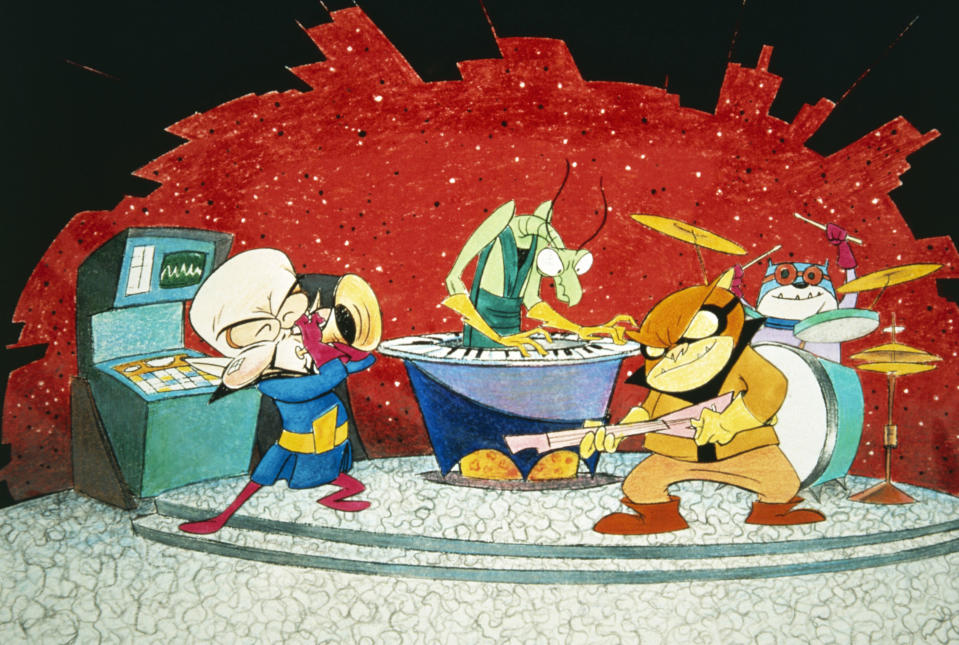‘Space Ghost Coast to Coast’ at 30: A Cable TV Hidden Delight for Fans of the Offbeat

- Oops!Something went wrong.Please try again later.
The frontier of late-night cable is lost. The streaming era has done some great things for accessibility – having hidden gems on demand is a cultural boon, when rightsholders care to make their libraries available. But the problem with having entertainment on demand is that you have to demand it. There’s a magic in accidentally finding something you seemingly weren’t meant to see, and for ‘90s kids, cable TV offered that special sort of danger that breeds self-discovery. For a generation of young minds ready to know the avant-garde and the off-beat, “Space Ghost Coast to Coast” was there.
Cartoon Network had never produced its own original programming before “Coast to Coast” debuted at 11pm on April 15, 1994. That might have made it a TV history footnote, but the peculiarity of the show made it special. Featuring live-action celebrity interviews mixed with recycled animation and character designs by the great Alex Toth from the short-lived 1966 Hanna-Barbera cartoon “Space Ghost and Dino Boy,” “Coast to Coast” used its cheapness for charm and its low profile as a license to experiment.
More from IndieWire
'The Holdovers,' 'Succession,' and 'The Bear' Win Top Prizes at WGA Awards (Complete Winners List)
'SNL' Parodies 'Barbie' and Taylor Swift as Emily Blunt Crashes Ryan Gosling's Monologue
The simple premise was born from the rhyme in its title. Washed-up TV superhero Space Ghost (voiced by George Lowe) hosts a late-night talk show with the “help” of his indentured archenemies, insectoid bandleader Zorak and molten director Moltar (both voiced by C. Martin Croker). Early on, the show’s humor derived mostly from the juxtaposition of sci-fi cartoon characters and Letterman-esque talk show patter, with Space Ghost fumbling through non-sequiturs and frequently asking guests if they were getting enough oxygen. The weirdness came from the retro-kitsch inherent to the assortment of guests, with the first handful of episodes alone featuring the Bee Gees, the Ramones, Timothy Leary, Bobcat Goldthwait, and the cast of “Gilligan’s Island.”
Then the episode “Story Book House” happened. Instead of Space Ghost, the audience is confronted with the unblinking live-action gaze of Kirk the Storyteller (James Kirkconnell), an elderly man seated in a local access-style faux-living room set recounting the events of previous “Coast to Coast” episodes in a vaguely eerie monotone. We’re left waiting for a punchline that never comes, wondering if the next episode will be a “normal” one.

“Coast to Coast” continued to fill its time slot with the occasional bit of performance art. “Fire Ant” runs double-length so Space Ghost can spend 11 uninterrupted minutes quietly following an ant. “Warren” loops three times for no discernible reason. “Brilliant Number One” and “Brilliant Number Two” are the same black-and-white nightmare scored by weird feedback and ringing phones, except one carries subtitles excerpted randomly from Shakespeare, while the other runs the words of Pablo Neruda across the bottom of the screen.
Even “normal” episodes of “Coast to Coast” had a mind-expanding quality, particularly for impressionable kids who accidentally encountered it by staying up too late with Cartoon Network on the CRT. There was the theme music by free jazz guitarist Sonny Sharrock and drummer Lance Carter, setting the show’s tone by being sonically wild in its deceptive sparseness. There were dadaist diversions delivered with the exquisite precision of an absurd drum solo. The show featured artists well outside the sphere of its target audience, like Laurie Anderson and Jim Jarmusch. It was impossible to predict what you’d get out of “Coast to Coast,” and hard to believe there were people out there putting it together. It felt conjured from deep space, a haunted broadcast mutated from some cosmic collision of comedy and modern art.
That feeling is a testament to the people who really did make it. Its spirit came from writers like Andy Merrill (who also voiced breakout character Brak), the team of Matt Maiellaro and Dave Willis (who would later create “Aqua Teen Hunger Force”), Khaki Jones, and Keith Crofford. Executive producer Mike Lazzo shepherded the show from a fledgling cable channel’s experiment into the foundation of the massively successful Adult Swim programming block. And there was C. Martin Croker, who not only voiced two lead characters but served as animation director. For some of us who grew up with Zorak and Moltar, Croker’s untimely death in 2016 hit almost as hard as losing Bowie and Prince a few months earlier.
“Space Ghost Coast to Coast” could only have happened when it did. It had to be that moment when cable was a vast landscape that could bring the handmade oddity of local-access shows to a nationwide audience of insomniac channel-surfers comfortable with not being entirely sure what they were looking at. It pulled from TV’s past and influenced the future of cartoon comedy, but there had never been anything quite like it and the landscape that spawned it is a distant memory now, in this time when idiosyncratic entertainment is easier to find but harder to discover. Still, the Ghost Planet turns in the hearts of fans who remember what it was like to feel like they were, for the first time, getting enough oxygen.
Best of IndieWire
The 22 Best Spy Movies, from 'Enemy of the State' to 'North by Northwest'
The 12 Best Thrillers Streaming on Netflix in April, from 'Fair Play' to 'Emily the Criminal'
Quentin Tarantino's Favorite Movies: 61 Films the Director Wants You to See
Sign up for Indiewire's Newsletter. For the latest news, follow us on Facebook, Twitter, and Instagram.

